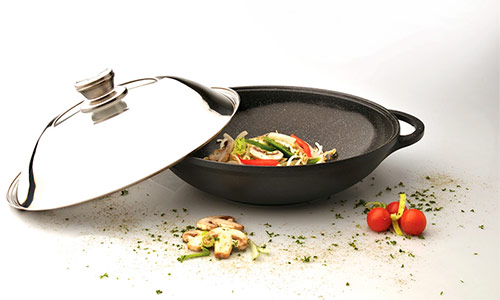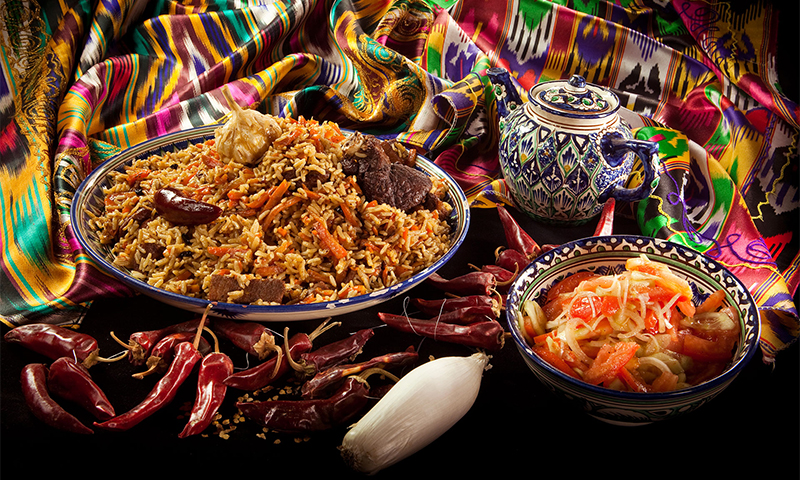All pots are good, as long as they are stored on store shelves. But it is worth starting to use new clothes, as it turns out that the dishes in it are burnt, fat traces and soot are not washed off the first time, and the favorite ladle leaves scratches on the walls. All these troubles can be avoided if the purchase is to pay attention not only to the design of the pan, but also on its main characteristics. What - read on.

Content:
The best manufacturers of pots - which company to choose
When choosing a pan, many go to extremes - some are looking for something cheaper and remain disappointed with the quality; others acquire super-expensive branded utensils, which serve for a long time, but do not pay for themselves.
It is better to dwell on good-quality utensils of well-established firms that are not trying to tear up the cost of their pots:
- Rondell;
- Tefal;
- BergHoff;
- Fissler;
- Konig.
There are other decent brands that produce good cooking utensils - for more information on their range you can find in a separate article. But first, let's define what kind of pans are needed in your kitchen, and there is a suitable option in the line of your favorite manufacturer.
Types of pots
Stainless
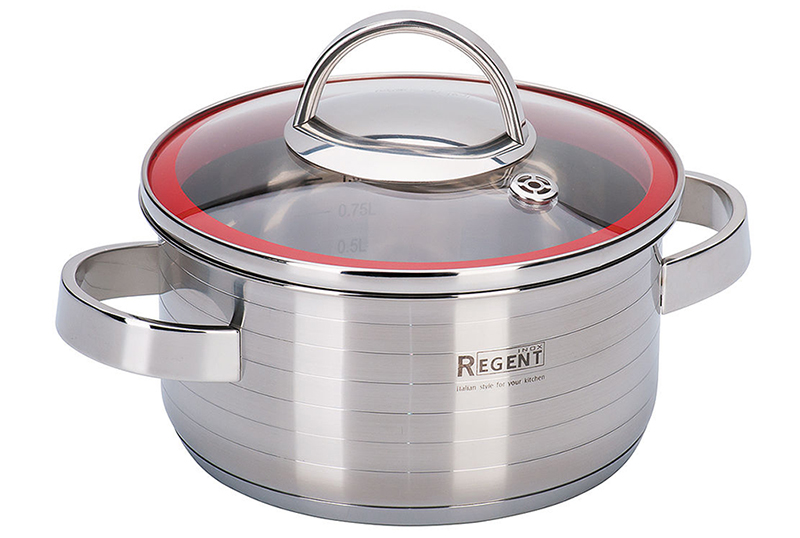
The ware from a stainless steel is in special demand. It is hygienic, stylish and with proper quality can serve for decades.
In such pots it is easy to cook any dishes, and a wide assortment in stores will allow you to assemble a set “for yourself” even from items of different series.
The bottom of steel pots is usually thickened due to multilayer inserts made of copper or aluminum - without them, the food would simply burn.
Pros:
- Simplicity in leaving - the stainless steel easily washes off any dirt and quietly tolerates the use of most cleaning products;
- Scratch resistant;
- Stylish design, under which you can choose any kitchen accessories;
- Fast heating;
- The multi-layered bottom evenly distributes heat and does not allow dishes to burn;
- High strength: the worst thing that can happen when a pan falls is a dent in the side;
- Versatility - stainless dishes work equally well with cooking liquid and thick dishes.
Minuses:
- Over time, stainless steel may tarnish or become stained;
- There are many poor quality fakes on the market.
Enameled
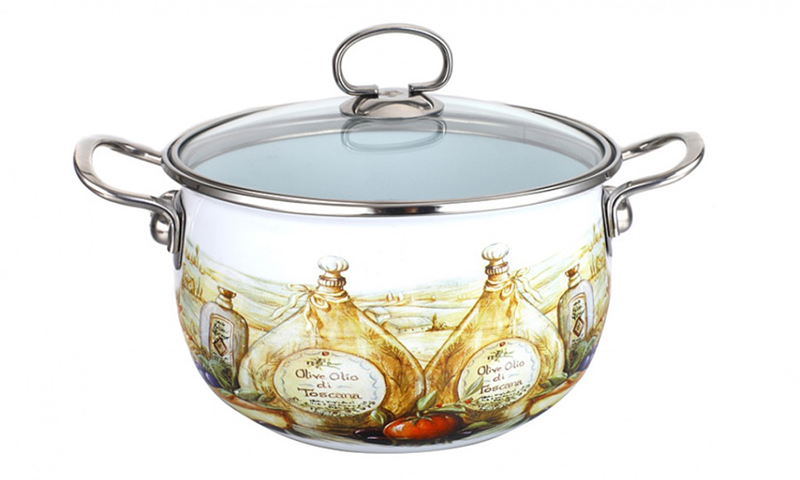
Steel or cast iron pots under a layer of bright enamel give a cozy look to any kitchen. They are quite strong and durable due to the large thickness of the walls, but their coverage is afraid of shocks.
Chips of enamel do not just spoil the appearance of the dishes - they bare metal, which without protection soon begins to rust. However, if the pothole turned out to be outside, for a while it would still be possible to use the pan without any problems.
Pros:
- A rich selection of colors and a variety of patterns on the enamel;
- Hygienic coating is easy to clean and allows you to cook any food, even with high acidity;
- Durable, non-deformable walls;
- Keep stainless food warm longer stainless steel.
Minuses:
- Enamel coating should be protected from pinpoints and abrasives;
- When chips appear inside the pan, it can no longer be used;
- Not suitable for the preparation of dairy and thick dishes (porridge, stew).
Cast iron
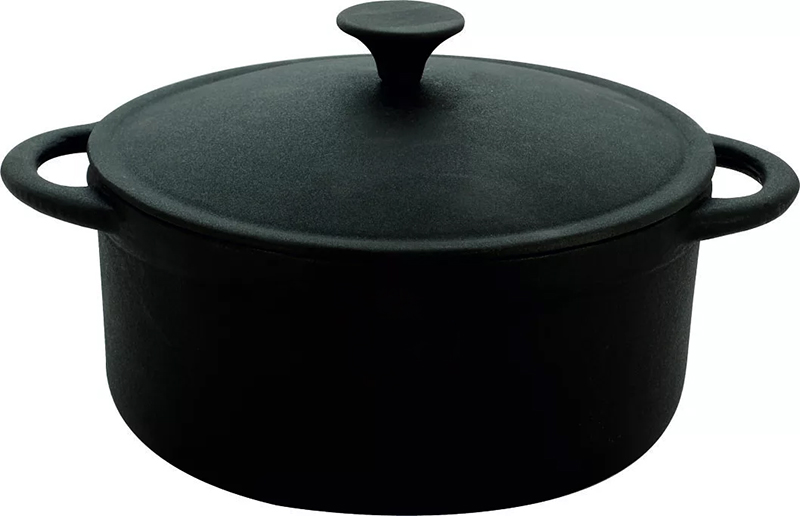
Heavy cast pans made of cast iron can be called unkillable - dropping such a vessel on the tiled floor, you would rather split the tile than the utensils themselves. However, cast iron, like steel, can rust without protection, so manufacturers today offer pots with enamel or non-stick coating.
The main advantage of cast dishes is a thick bottom and walls with a high heat capacity. It is good to bake and simmer dishes in it, and the prepared food here retains its heat for a long time.
Pros:
- Very strong and durable;
- They tolerate high temperatures calmly and can even be used for baking in the oven;
- They keep the temperature of ready meals for a long time and are quite suitable for their storage;
- Not afraid of abrasive cleaning;
- They have good non-stick properties (with the exception of models with enamel coating).
Minuses:
- Heavy;
- They heat up for a long time;
- After washing, uncoated pots must be oiled to prevent rust.
Ceramic
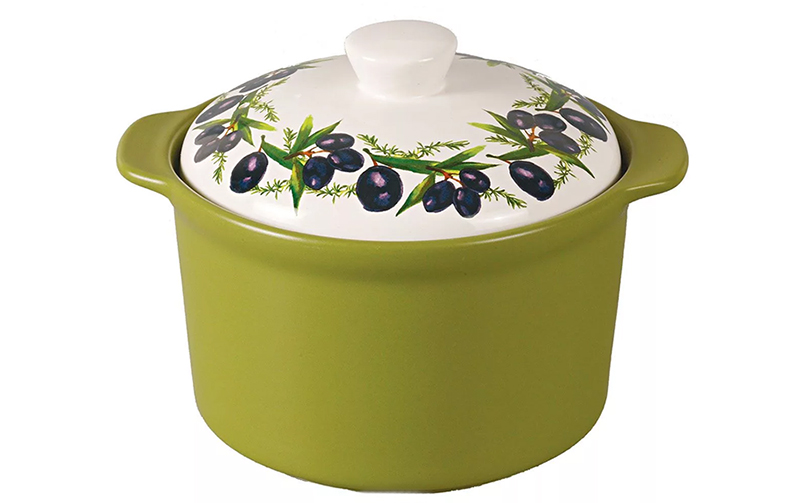
Very beautiful and eco-friendly pots are suitable for cooking on the stove and in the oven. They easily withstand high temperatures, although sudden drops in their contraindicated - can burst.
Ceramic utensils are valued for their long-term preservation of heat, but the most important thing is that any food in it is tastier.
Pros:
- High scratch resistance;
- Easy cleaning;
- Thick bottom and walls distribute heat well, allowing products to languish in their own juice;
- The food in them practically does not burn;
- You can put in a microwave.
Minuses:
- Fragile pottery is afraid of shocks and falls;
- Great weight;
- Can not be used on induction cookers, but you can buy a combined pan with a metal bottom.
Glass
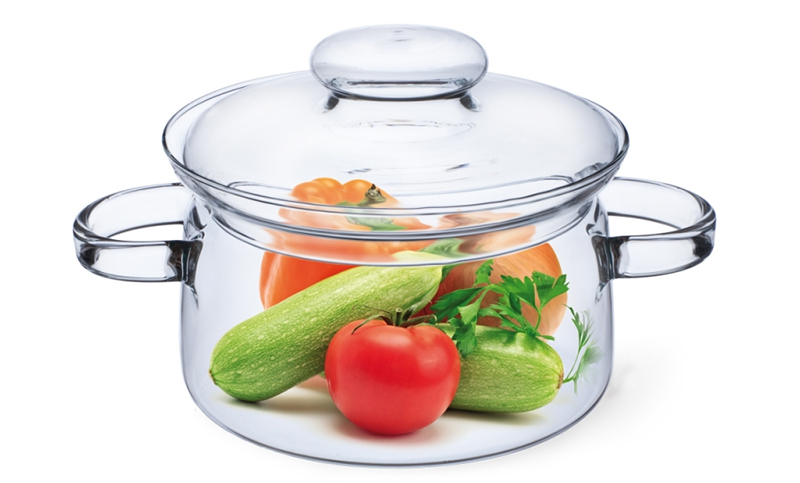
The pan, made of fireproof glass, is absolutely hygienic, safe for health, and does not burn anything in it. Heat-resistant material allows you to cook in the oven and on the stove, and you can wash such dishes by any means (even with a metal scraper).
Many housewives glass scares away its fragility, but with careful handling, it can last a really long time without losing its attractive appearance.
Pros:
- Easy to clean, even with very difficult dirt;
- Do not absorb the smells of products and do not stain;
- Suitable for cooking in the microwave and oven;
- Food in glassware does not burn;
- Absolutely eco-friendly.
Minuses:
- They are afraid of sudden changes in temperature;
- To cook on a gas stove, you will need a special divider;
- With a strong blow may break up;
- Not friends with induction.
Aluminum
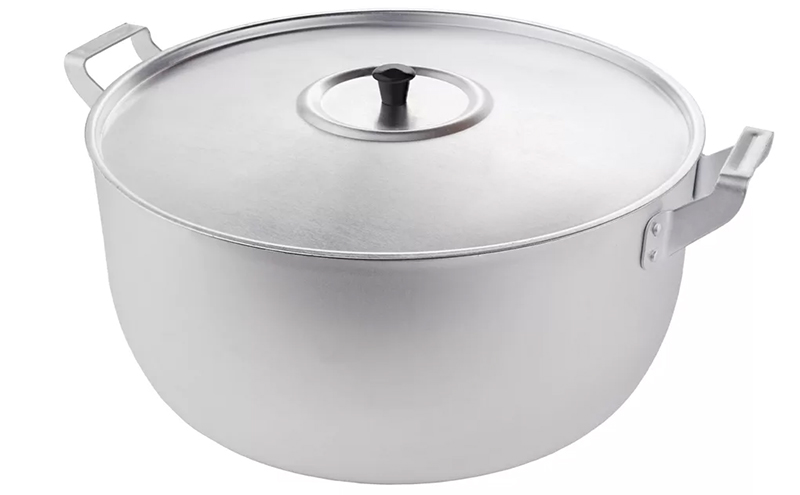
These pans can be of two types - extruded from thin-sheet aluminum or cast. The first are distinguished by an affordable price and low weight, but they are too easily deformed, so they are not very popular.
Thick-walled cast saucepans in their operational properties are close to cast iron, but unlike it they do not rust and heat up much faster.
Pros:
- Easy to clean;
- Heat up quickly and cool down just as quickly;
- Can be used for cooking both on an open fire, and on electric rings (with the exception of induction);
- They are relatively inexpensive.
Minuses:
- Products can burn even in thick-walled cast vessels;
- Aluminum without protective deposition quickly oxidizes, darkens and becomes stained or salted;
- They can not cook sour dishes (borscht, compotes), and even more so you should not leave the products in such dishes after cooking.
Copper
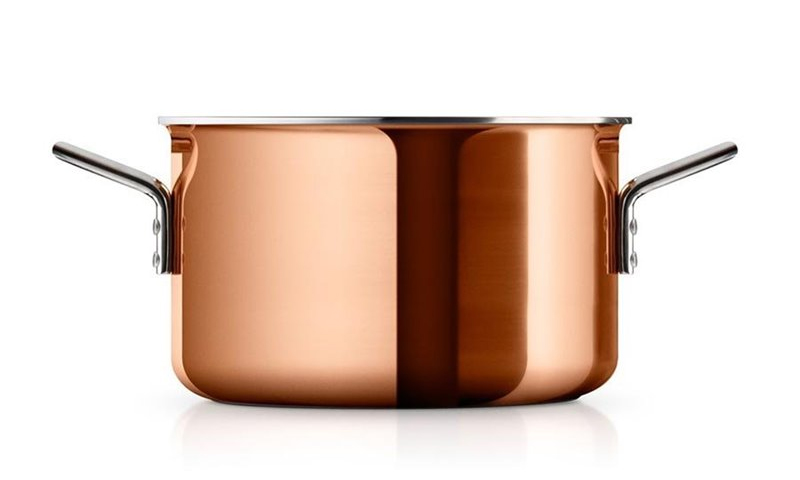
Beautiful, but expensive dishes again returned to our kitchen. Dishes in it are always tasty and stored longer due to the antibacterial properties of copper. Unfortunately, it not only kills pathogens in foods, but also destroys the vitamins contained in them.
Such pans have one more unpleasant feature - they will have to be regularly polished to a shine. Once you wash off the protective coating, you start an endless oxidation process that you will need to fight.
Pros:
- Chic appearance;
- They heat up twice as fast as aluminum pans and 10 times as fast as stainless steel;
- The food in them almost never burns;
- Modern utensils are already protected from the inside, which allows to avoid contact of copper with products.
Minuses:
- High cost plus sophisticated care;
- Not suitable for cooking sour dishes;
- If the pots are not wiped dry, patina stains will appear on them very quickly.
Pan selection options

Volume
The average family has enough 3-4 pans for cooking the main dishes. In any case, when choosing them, you need to focus on your usual menu:
1. 1-1,5 l - such saucepans are suitable for cooking cereals, eggs, sausages, cooking goulash or stews. Lonely people of this volume will be enough for the first.
2. 2.5-3 liters is enough to cook a soup or stew for a family of 2-4 people. If it is not possible to cook dinner every day, it is better to take the dishes more displaced - 3.5-4 liters.
3. From 5 l - such pans are rarely used. As a rule, they are needed to cook compotes or festive dishes for a large feast. If this is not your case, do not rush to spend money on the purchase of such utensils.
Thickness of the bottom and walls
From the thickness of the walls depends on the service life of the pan. The optimal indicator for sheet metal utensils is 0.5-0.8 mm. Smaller thickness is found on the budget dishes, but it is necessary to pay for it with curved sides and dents.
Eminent manufacturers offer pans with walls of 1-2 mm - they are more expensive, but serve almost forever. For cast, glass and ceramic utensils, the thickness does not matter so much - it is always sufficient here.
But the bottom of any pan should be thick so that the heat is evenly distributed over its surface, and the products do not burn. It is difficult to achieve this in stamped products; therefore, metal utensils are today equipped with a multi-layer encapsulated bottom.
Here between two thin sheets are hidden thick disks made of different materials:
1. Copper - provides a quick warm-up, but increases the cost of dishes;
2. Aluminum - heats up too quickly and costs less than copper;
3. Ferromagnetic alloy - allows you to use a pan for cooking on an induction stove.
The optimum thickness of the bottom of the pan is 7-8 mm - this allows you to achieve a good heating rate and at the same time uniform heat distribution.
Quality pens
The handles at the pans can be solid if it is a heavy cast-iron, ceramic or glass dish, or attached to the sides in different ways:
1. Spot welding - the most reliable mounting option, moreover, because of the small contact area, the handle will be less heated from the pan.
2. Riveting or bolts - this fastener looks neater, but on the inside of the dishes it will always be clogged with particles of food, and sometimes it will rust.
Pay attention to the fact that the pan handles are long enough - and it is more convenient to take on them, and they will not be able to heat up much. Otherwise, it is better to look for products with hollow tubular handles or lining of bakelite, heat-resistant silicone or wood.
Which pot to choose

1. For the preparation of first courses, cooking pasta, ravioli and other products that require a large amount of water, an enamelled pan of 2-3 liters is quite suitable. You can take a stamped model of cheaper aluminum or fork out for stainless steel, and even copper. There is nothing to burn in such a dish, but it should be heated as quickly as possible, so the thickness of the bottom and walls of 0.5 mm will be enough.
2. For second courses (porridge, pilau, thick stews) thick-walled dishes with a capacity of about 2 liters are more suitable. Such food is tasted best in a ceramic saucepan, but you can use cast iron or cast aluminum. Only in the case of metals, it is desirable that the inside had a protective coating: Teflon, marble, at worst - enamelled.
3. If you often cook in the microwave, buy a saucepan made of thick glass or ceramic. Capacity of 1.5-2 liters will be enough.
4. Cooking dairy dishes and sauces is best in copper dishes, but it should have an additional inner layer of stainless steel and long tubular handles. In a family, one such saucepan with a capacity of no more than 1-1.5 liters is sufficient.
5. Often cook compotes, brawn or jelly? Get yourself a roomy saucepan of 5-7 liters made of enameled or stainless steel with a thick bottom. Pay special attention to the handles - they must be welded reliably, since they will have a large load.
6. For an induction cooker, the pots must be carefully selected. Make sure that the utensils have a thick, encapsulated bottom - even or slightly concave. Also check its magnetic properties - to do this, just bring the magnet to the bottom from the outside (it should immediately “stick”).
How much is the pot

1. Stainless steel pans are priced from 300 rubles to 30 thousand - it all depends on the brand's fame and, to a lesser extent, on volume.
2. Enameled sold within 200-8000 rubles.
3. A good quality cast-iron pan with coating can be bought for 1-17 thousand rubles. Domestic manufacturers offer budget options without enamel for 700-3000 rubles.
4. Ceramic utensils cost from 500 to 5000 rubles.
5. The choice of glass pots is not rich, but you can find a suitable option for just 400-2000 rubles.
6. Prices for aluminum dishes start from 200 rubles for thin-walled punching and reach 18-20 thousand for cast pans with modern non-stick coating.
7. Copper utensils are not cheap - all pots of nonferrous metal are in the price range of 12-42 thousand rubles.
It will be interesting to friends too






